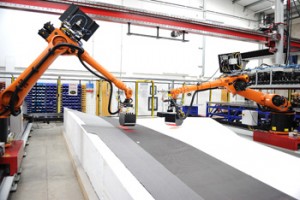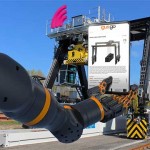Composites manufacturing for the aerospace sector
 The manufacturing of aircraft could soon look dramatically different, thanks to a programme run by the Technology Strategy Board. The one-year i-Composites programme saw KUKA, together with project partners Loop Technology and Güdel, as part of a wider consortium, looking at ways of developing affordable composites manufacturing technologies.
The manufacturing of aircraft could soon look dramatically different, thanks to a programme run by the Technology Strategy Board. The one-year i-Composites programme saw KUKA, together with project partners Loop Technology and Güdel, as part of a wider consortium, looking at ways of developing affordable composites manufacturing technologies.
KUKA Systems, in conjunction with Bombardier Aerospace, devised an innovative robotic cell for laying up dry carbon fibre material as a result of a national research and development project. The focus was on the cell’s potential use in future wing production and is currently being trialled at Bombardier in Belfast. It aims to process dry carbon fibre material more quickly and efficiently than the existing method.
Depending on the size and profile of the wing structure, up to 200 plies may need to be put in place, which can be time-consuming due to the material’s flexible nature and tricky application technique.
The robotic cell features a 12m x 1.5m gripper matrix, which comprises an array of vacuum suction cups. These pick up a flat ply and transport it in the gripper along a gantry system to the mould tool. The gripper array then reconfigures to a contoured form before placing the ply accurately into the mould. Furthermore, the number of suction cups activated can be altered to suit different ply sizes.
Once the laying up operation is complete, a KUKA KR30 robot with twice the reach capabilities of a standard model, picks up an end effector equipped with a vision system and travels along a linear track to inspect multiple pre-programmed locations on the preform. The camera checks the edges and weave angle to ensure the plies are positioned properly and within the correct tolerances. An alarm is triggered if an error is detected. The robot then returns to the workstation to replace the end effector with a similar tool containing an induction iron. It is used to tack the plies together in preparation for the preform to be processed further.
“The cell was completed within the year and we are extremely pleased with its performance during this early development phase,” commented Gavin Campbell, director, design engineering and technology department, Bombardier Aerospace, Belfast. “With further development and trialling, we believe there is an opportunity for future application on aircraft wing programmes. The technology may also be attractive to others working in the field of composites such as the marine, automotive and sustainable energy sectors.”
Mark Schlanker, business manager at KUKA Systems, said the cell had also been designed to deliver more efficiency to the laying up and tacking process with the option to add more robots at a later date.
Visit the KUKA website for more information.
See all stories for KUKA















